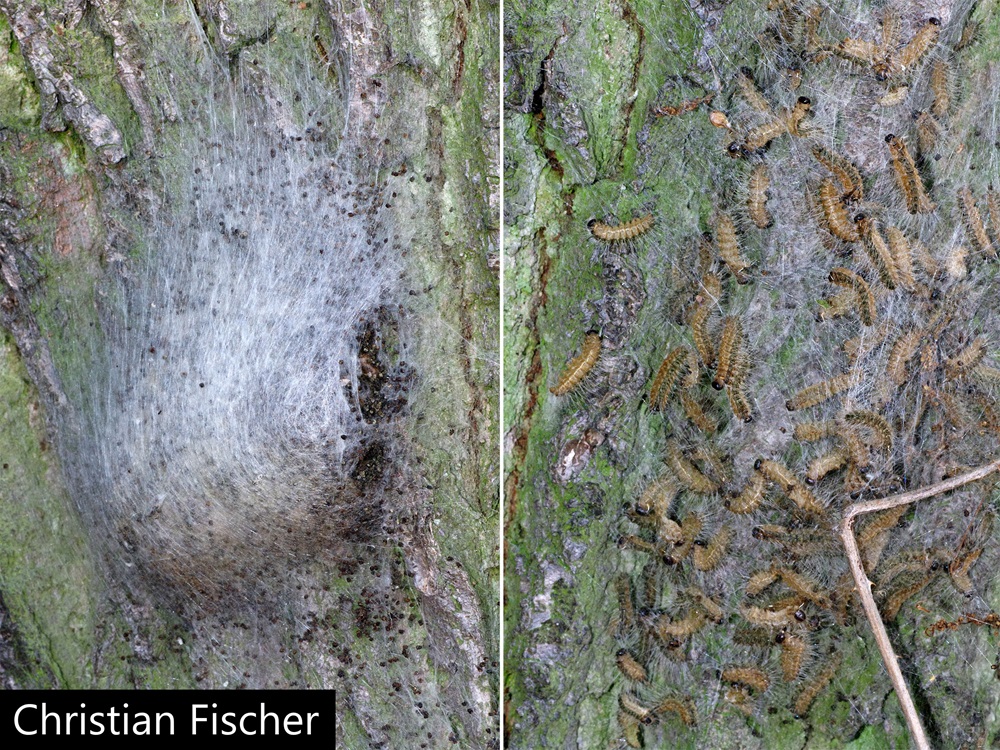By Sarah Gwilliam November 17, 2024
Oak trees are a cherished feature in many gardens, offering shade and enhancing the landscape’s beauty. However, they can sometimes become hosts to the Oak Processionary Moth (OPM), a pest that poses risks to both tree health and human well-being. This guide is designed for everyday gardeners, helping you identify OPM and understand how to respond safely and effectively.
What Is the Oak Processionary Moth?
The Oak Processionary Moth (Thaumetopoea processionea) is an invasive species native to southern Europe but has spread to other regions, including parts of the UK. The moth’s caterpillars are of particular concern due to their distinctive behavior and the health hazards they present.

Key Characteristics:
- Processions: Caterpillars move in nose-to-tail lines, resembling a procession.
- Irritating Hairs: Their bodies are covered with tiny, toxic hairs that can cause health issues.
- Seasonal Appearance: Caterpillars are most active from late spring to early summer.
Why Is OPM a Problem?
Health Risks:
- Skin Irritation: Contact can lead to rashes, itching, and dermatitis.
- Respiratory Issues: Inhaling the tiny hairs may cause sore throats, breathing difficulties, or allergic reactions.
- Eye Irritation: Hairs can cause conjunctivitis and other eye problems.
- Pets at Risk: Animals can also suffer similar symptoms if exposed.
Tree Health Concerns:
- Defoliation: Caterpillars feed on oak leaves, weakening the tree by reducing its ability to photosynthesize.
- Increased Vulnerability: Weakened trees become more susceptible to other pests and diseases.
How to Spot Oak Processionary Moth

Identifying the Caterpillars:
- Appearance: Greyish bodies with dark heads, up to 2 inches (5 cm) long.
- Distinctive Hairs: Covered with thousands of tiny, barbed hairs.
- Behavior: Move in long, snaking lines along tree branches and trunks.
Recognizing the Nests:
- Location: Found on the trunks and branches of oak trees.
- Appearance: Silken, web-like nests that are white when fresh but become discolored over time.
- Season: Visible primarily from May to July.
Adult Moths:
- Appearance: Less distinctive, with grey-brown wings and a wingspan of about 1.2 inches (3 cm).
- Activity: Nocturnal and seen from July to September.
What to Do If You Find OPM
Do Not Touch:
- Avoid Contact: Do not touch or disturb the caterpillars or nests, even with gloves or tools.
- Keep Distance: Ensure children and pets stay away from affected areas.
Report the Sighting:
- In the UK: Report to the Forestry Commission via their Tree Alert online form or call the OPM helpline.
- Provide Details: Include the location, date, and any photos taken from a safe distance.
Call in a Professional:
- Licensed Pest Controllers: Only trained and equipped professionals should handle OPM removal.
- Prompt Action: Early intervention can prevent the spread and reduce health risks.
Why You Need a Professional
Health and Safety:
- Protective Equipment: Professionals have specialized gear to prevent exposure to toxic hairs.
- Safe Removal: They use approved methods to remove and dispose of nests and caterpillars.
Legal Regulations:
- Compliance: Handling OPM may be subject to local laws and regulations.
- Environmental Safety: Ensures that control measures do not harm other wildlife or the environment.
Expert Assessment:
- Accurate Identification: Professionals can confirm whether the infestation is OPM or another species.
- Tailored Solutions: They can provide advice on preventing future infestations.
Preventative Measures for Gardeners
While professional help is essential for dealing with OPM, you can take steps to protect your garden:
Regular Monitoring:
- Inspect Oak Trees: Check your trees regularly, especially from spring to mid-summer.
- Early Detection: Spotting signs early can make management more straightforward.
Garden Hygiene:
- Remove Debris: Keep the area around oak trees free from leaf litter and fallen branches.
- Limit Attractants: Reduce outdoor lighting at night to avoid attracting adult moths.
Personal Protective Measures:
- Protective Clothing: When gardening near oak trees, wear long sleeves, trousers, and gloves.
- Wash Up: After gardening, wash clothes at high temperatures and shower to remove any hairs.
Understanding the Limitations
No DIY Removal:
- Risk of Exposure: Attempting to remove nests yourself can lead to serious health issues.
- Ineffective Methods: Home remedies are unlikely to solve the problem and may worsen it.
Don’t Ignore the Problem:
- Health Hazard: OPM poses a real risk to you, your family, and pets.
- Tree Damage: Left unchecked, infestations can severely weaken your oak trees.
Health Precautions
If Exposed:
- Skin Contact: Wash the affected area with soap and water.
- Eye Contact: Rinse eyes gently with clean water.
- Inhalation: Seek fresh air and monitor for symptoms.
Seek Medical Attention:
- Persistent Symptoms: If you experience severe or lasting reactions, consult a healthcare professional.
- Inform Professionals: Let medical staff know about potential OPM exposure for appropriate treatment.
Frequently Asked Questions
Can OPM Affect Other Trees?
- Primary Hosts: OPM primarily targets oak trees but may occasionally be found on other species.
Is OPM Dangerous to Pets?
- Yes: Pets can suffer similar symptoms if they come into contact with the caterpillars or hairs.
How Widespread Is OPM?
- Regional Presence: OPM is established in certain areas; check with local authorities for information specific to your region.
Conclusion
The Oak Processionary Moth presents a significant challenge for gardeners, but with awareness and prompt action, you can help protect your health and preserve the beauty of your oak trees. Remember, dealing with OPM is not a DIY task—always involve professional pest control services.
Stay safe, stay informed, and happy gardening!
Useful Resources
- Forestry Commission (UK):
- Local Council or Agricultural Extension Service:
- Contact for region-specific advice and assistance.
Please share this guide with fellow gardeners to spread awareness about the Oak Processionary Moth. Together, we can help protect our trees and communities from this harmful pest.

